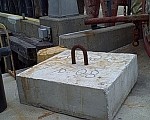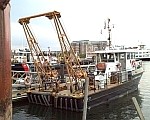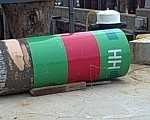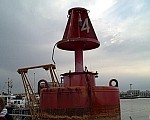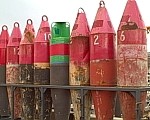Boat Safety – Week/Lesson 3
Tonight’s lesson began outside as we learned about the red and green markers in the channels (aka ATONS or Aids to Navigation System).
The red (Nun) markers have even numbers on them and should be on your Right (starboard) when coming into the channel. This is also sometimes known as Red Right Return.
The green (Can) markers have odd numbers on them and should be on your Left (port) when coming into the channel. The numbers should also be going up as you enter back into the channel. As you follow your chart, you will also see these markers clearly labeled.
The green and red striped marker (with green on top) means this is preferred channel to starboard.
A black-topped white buoy (not shown) means pass to the north or east of buoy. A red-topped white buoy (not shown) means pass to the south or west of buoy.
The last two photos here show the actual buoy tender used to put the atons into the water (or remove them) and the weight used to keep them down.
- Weight for markers
- Buoy Tender
- Striped Green and Red Can
- Red Day Marker
- Nuns and Cans
- Nuns and Striped Can
The last thing we did before heading back inside was to watch a few of the boats and discussed the lights being used. Did you know that if the light up top near the captain is green, then you have the right of way to pass? But, if it’s red, don’t even think about it. They basically have the same meaning as when you drive a car.
And before I forget (2 things)
- the numbering and colors on the atons mentioned above only work in countries that drive on the right side of the road. So, in countries like the UK where they drive on the left, the markers work the same way in their waters.
- Nevertie your boat up to any aton
Now back to the whiteboard.
International and Inland Rules –
Rule number 1 – International Rules apply to all vessels in the oceans, rivers and bays
Inland Rules apply to waters in the United States
Here’s a great neumonic for remembering who has the right of way.
Our new reels catch fish so purchase some –
Our – overtaken
New – not under command
Reels – restricted
Catch – constrained by draft
Fish – net, trawlers & the like (once done fishing you’re considered a powerboater)
So – sail (only have right of way if not any of above capacity and not under power)
Purchase – power
Some – seaplane
Depending on the situation you’re in or the work you’re doing (top 5 in list above), then you are either under sail, power or a seaplane.
LNG’s, tugs and barges all have right of way. If these vessels have to stop for any unexpected reason, they will continue moving for 1.5 miles before coming to a complete stop so stay out of their way. Also, there is a 1,000 mile rule around any USCG boats.
You’re responsible for your own wake.
Radio –
Channel (Ch) 13 is for captain-to-captain talk
Ch16 – do not chatter on this one
Ch81A is for Coast Guard only – don’t talk on this
If you’re coming to a bridge that needs to be opened, hail 13 – call the bridge person “Captain” then offer them some cookies, etc. (bribery works), otherwise you’ll be sitting for a bit.
Overnights – you should have 2 anchors, signaling devices, radio, flares, flags, etc.
Do not risk your lives for anybody or anything!
Man overboard/pre-trip checks
if a person is in the water the first thing you need to do is yell man overboard port or starboard. If you’re on a powerboat, this helps the captain know to turn the opposite screw.
Next, keeping your eye on this person use your full hand to point in the right direction (not your finger).
Then, throw a type IV PFD (personal flotation device) out to them (usually a ring or square cushion)
What to tell your guests when you go out on your boat.
– how the toilet works if you have one on board
– where the fire extinguishers are and how to use them
– where the life jackets are and have them fit one to their body (make sure they’re out of the cellophane)
– where the throw ring is
– show them the chart
– show them how to take the helm
All these things help you look confident, show your guests that you know what you’re doing, which in turn makes your guests feel comfortable being on the boat with you. G-d forbid something happens to you, your guests need to know how to take over.
Departing and returning to a dock –
If you’re in a power boat, you’ll find half the time it’s best to leave the dock with the stern. To do this, put the fender close to the bow, push on it, then backup. If you have someone on board with you, have them position the fender alongside the bow so you can back up.
Conversely, it’s better to back in.
Anchoring –
It’s best to have 2 anchors on your boat, especially if you’re going to do overnights. You’ll also need a chain on each anchor. The chain’s purpose is to allow your line to have scope (shock absorber). The length depends on the deepest water that you plan to be in then times 7 (aka scope of 7:1). So if you will be staying in 20-ft. water, you’ll need an anchor that’s 140-ft.
Before you drop anchor, you’ll need to check the bottom and its depth. If you can’t see the bottom, make sure you check it on your chart. Then check to make sure the rode is scurely tied to the boat, but not to the side or only the stern of your boat. Once you drop anchor, back up to let the rode out, then come back in half way. This gives you a more secure (taut) line and keeps you from drifting too much. Also, note what’s around you (church, restaurant, etc). This will help guide you. If your surroundings change, then you have a problem with your anchoring.
Towing a Skier –
You, as the captain, always need to be watching in front and back.
Adverse Weather –
Winds coming in from the Northwest are highs, from Southwest are storms (at least here in New England).
High pressure – the air goes outward, low pressure – the air goes inward. A front is in between a high and low.
Cold air comes under warm air. It condenses moisture, then causes thunderstorms. So watch the clouds.
Little wisps are start of arriving fronts. They also look like fingers of ice and are known as the cirrus clouds.
Stratta clouds are flat clouds that go across the sky.
Clouds that clump or look like balls are either rain or snow.
A seabreeze rises 35k feet and clouds look like an anvil. It sucks wind from every direction. Then the friction causes thunder and lightning, which in turns gives the sheets of rain.
When this happens, make sure everybody on your boat puts on their life jackets, gets below (if possible). The one thing you don’t want to do is get cold and goopy wet. If you’re wearing glasses, take them off (you can’t see with them anyways). On a sailboat? Heave-to.
If a hurricane is approaching and you can’t stop, then go around (peel off) and get yourself to the 8PM marker.
In Boston? Ch3 has weather forecast. Cape Cod? Ch2. Everywhere else – www.sailcast.com
That’s it! we’ve covered a lot here. Any questions, just ask and I’ll do my best to get you an answer. Homework is read chapter 6 & 7.
